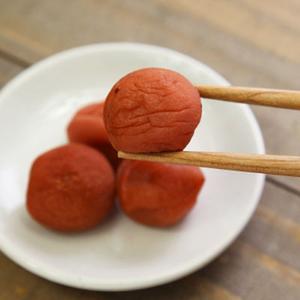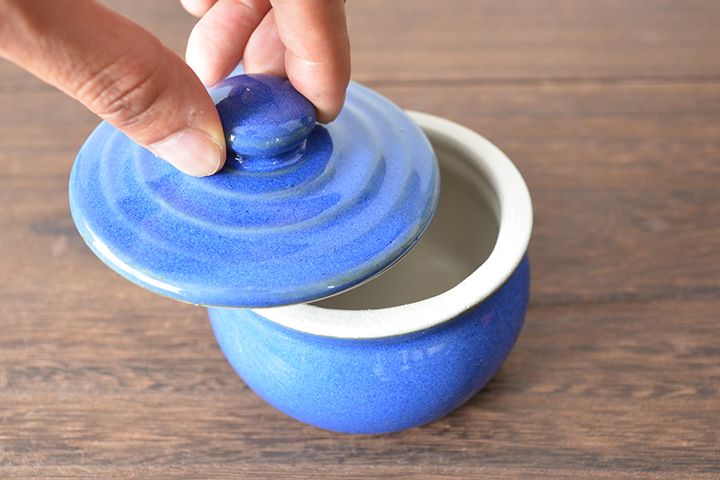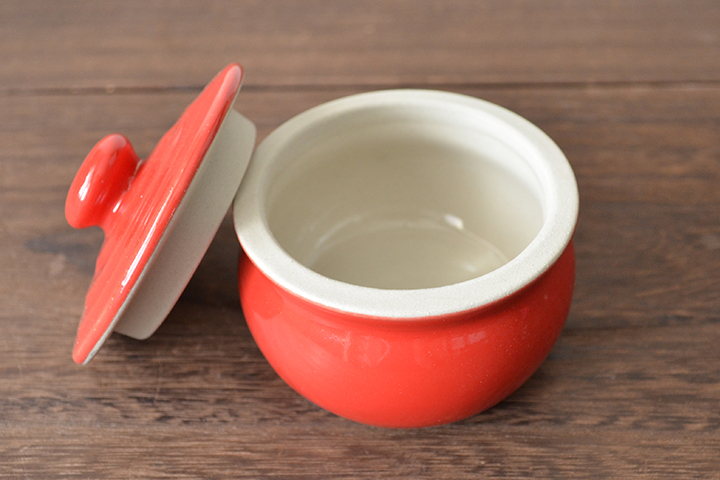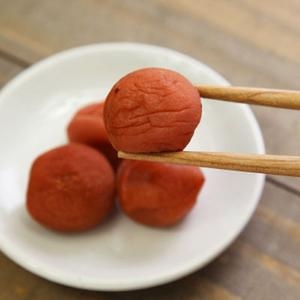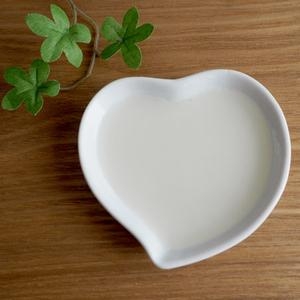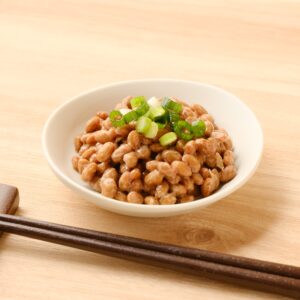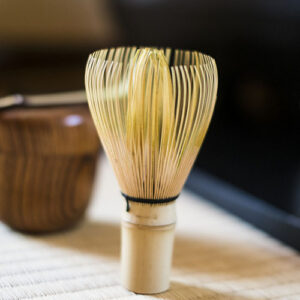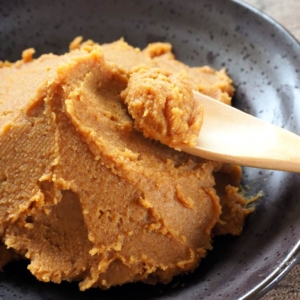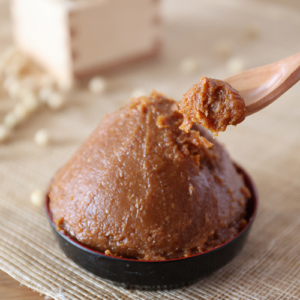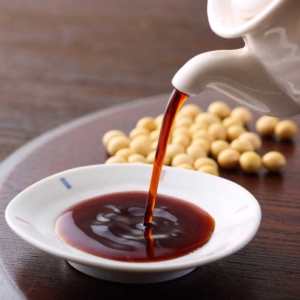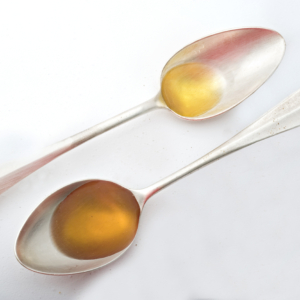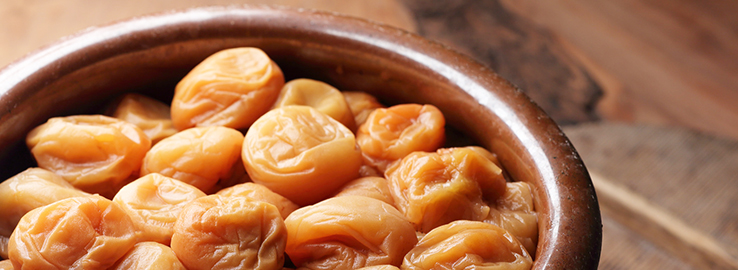
Have you tried umeboshi? What is umeboshi?
In Japan, umeboshi is an essential everyday foodstuff. It is not only enjoyable on its own, but the medicinal effects caught worldwide attention. Vegans are also gaining interests in this superfood because of the abundant nutrients.
In this article, we will introduce all about umeboshi: its history, health benefits, frequently asked questions, how to deliciously enjoy umeboshi and more.
 Content List
Content List
- What is Umeboshi?
- Umeboshi is a dried, salted fruit of Prunus Mume Tree
- “Sour and Salty” – The Taste of Umeboshi
- Umeboshi Products Variants
- Over 2000 Years History of Umeboshi
- Health Benefits of Umeboshi
- How to Choose Delicious Umeboshi
- Wakayama Prefecture is Famous for its Umeboshi
- Are dotted Umeboshi safe for consumption?
- How to Eat Umeboshi Deliciously
- “Umeboshi” is the Typical Ingredient for “Onigiri”
- Other Ways
- How to Remove Salt Content from Umeboshi?
- How to Store Umeboshi?
- Q&A About Umeboshi
- Recommended Products
What is Umeboshi?

Umeboshi (梅干 or 梅干し), literally means “dried ume” or “dried plum” is pickled ume (plum) fruits that is traditional to Japanese cuisine. Japanese people began making umeboshi during the Heian period (794-1185). It is still loved by many Japanese people today.
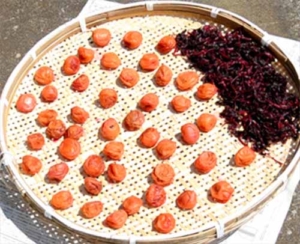
Umeboshi is a dried, salted fruit of Prunus Mume Tree
Ume (Prunus mume) is a species of fruit-bearing tree in the genus Prunus, which is often called a plum but is actually more closely related to the apricot.
Prunus Mume is a deciduous tree that starts to bloom in mid-winter (January-February) and the fruit ripens in early summer (June-July) in East Asia.
The ripe fruits are used to produce umeboshi.
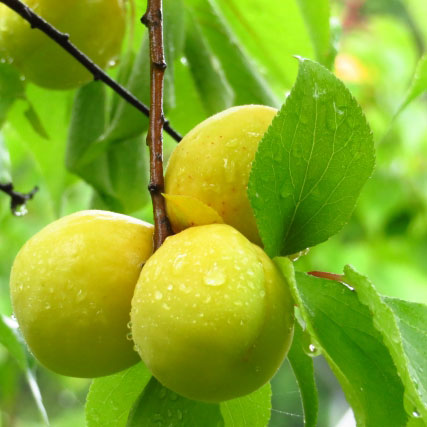
“Sour and Salty” – The Taste of Umeboshi
Umeboshi is one of the most popular tsukemono (pickles) in Japan. It has a lovely tartness and tanginess which often tastes sour and salty due to the citric content. When pickled with honey, a fruity flavour from the sweet-sour combination produces sweet Umeboshi. Some umeboshi are fermented for longer in the span of 3, 4 years or more which produces rich umami flavour.
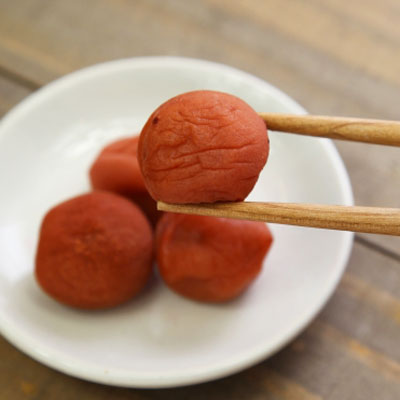
You can learn more detail about 3 years matured umeboshi here
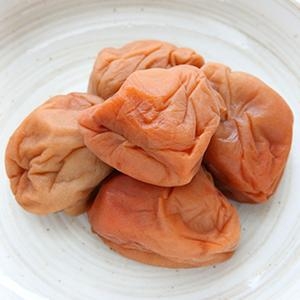
Umeboshi Products Variants
There are many ways Umeboshi can be enjoyed. Here, we introduce a few staple product variations made with Umeboshi.
Umeboshi
Ingredients:
Ume (plums), salt
The most traditional type of Umeboshi is salted Umeboshi. In its purest form, this Umeboshi is eaten on its own, or combined with rice as a meal. Umeboshi is also a favourite for tea-lovers who is seeking for that refreshing kick.
Ume is plums, an Asian fruit similar to the apricot; umeboshi is “dried ume” or “dried plum”- a long-standing pickled plum fruit in Japan. The ume plum is a Japanese fruit used most often as a condiment, which is referred to as umeboshi plums.
Not just for marinade, you can use shio koji to boost the flavor of sauces, salad dressings, and pickles. Enjoy the slight sweetness and pleasant salty flavor from this magic seasoning.
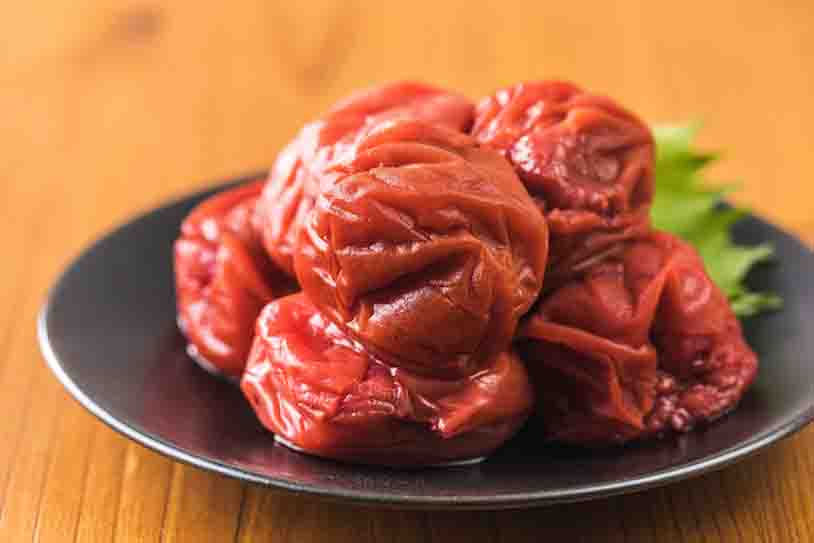
Umeboshi Puree/Paste
Ingredients:
Organic Ume plums, soy sauce, ume vinegar, perilla leaves, ginger
Umeboshi paste is a puree derived from ume, made by smashing umeboshi into a pulpy liquid.
The paste is sour and salty, similar to that of umeboshi but in a different form. You might say this is truly an innovative product!
Tips to enjoy umeboshi paste to the fullest!:
● Mix umeboshi paste in Caesar salad dressing sauce,
● Use it as the alternative to salt and vinegar,
● Enrich the flavor and balance the sweetness in soups, broths, or sauces,
● Mix umeboshi paste with miso to make the ‘cheesy vegan sauce’,
● Use it as a regular condiments.
Umeboshi paste is versatile not only in Japanese cuisines such as sushi, onigiri (rice balls), or miso dishes, but also in international cuisines like pesto, Thai curry, risotto, etc.
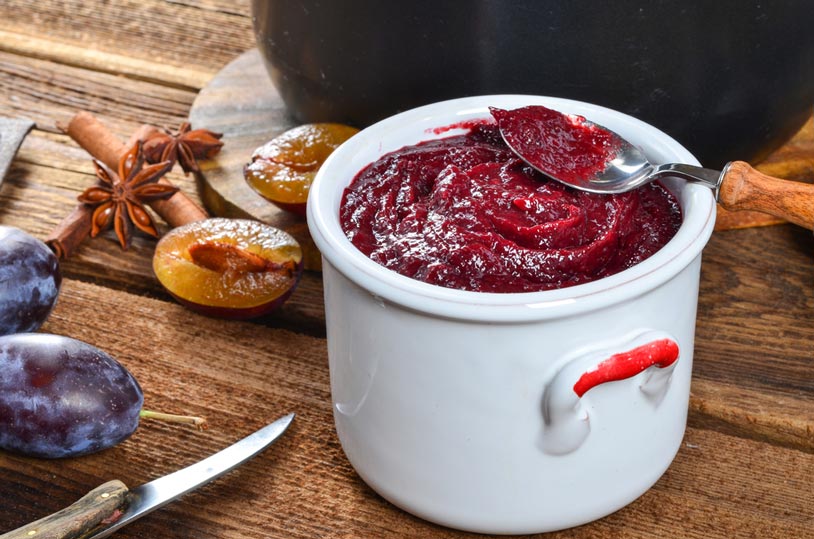
Crushed Umeboshi
Ingredients:
Organic Ume plums, salt, perilla
These are basically Umeboshi that has small scratches, lose their shape or unselected for the pickling process.
Even so, this does not affect its authentic taste. Crushed Umeboshi can be enjoyed with rice, the Japanese way of making Chirashi sushi (mixed rice typically eaten with raw fish). Crushed Umeboshi adds a slight tanginess and enhances the overall experience.
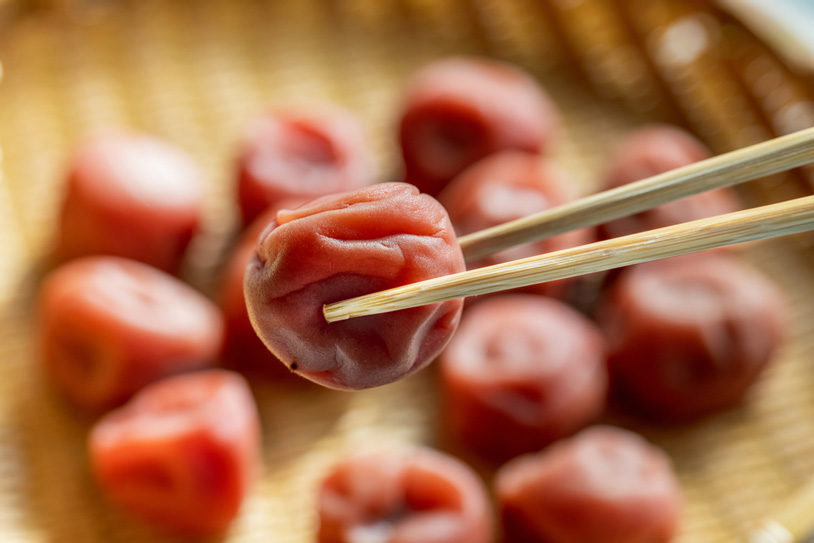
Umeboshi Vinegar
Ingredients:
Plums, salt, red perilla/ Shochu
Ume Plum Vinegar (梅酢) is the juice extracted when making umeboshi.
Made from umeboshi and shiso leaves, this fruity vinegar is often found in Japanese dishes for its lovely tart, fresh flavour to salad dressings, pickles, vinegared rice, beverages, steamed vegetables, dips, sauces, and food spreads. It can also be creatively applied to vegan dishes or bringing your taste to the plate. The possibilities are endless!
The pickling liquid, which is now umeboshi vinegar, or ume-su as it’s called in Japanese, is a fabulous flavorful vinegar for vinaigrettes.
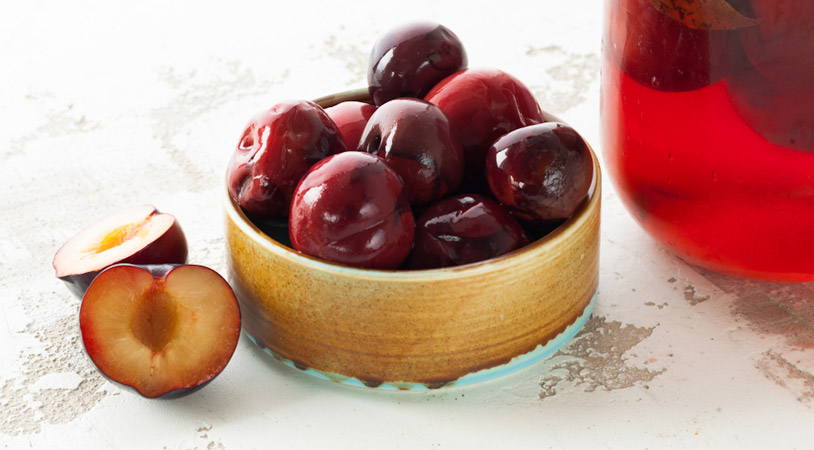
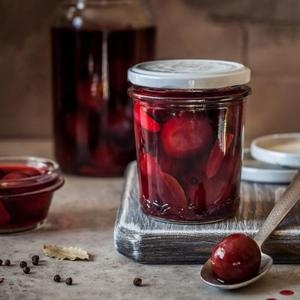
Umeboshi contributes to an endless exploration and creativity to Japanese gastronomy. Yum!
Over 2000 Years History of Umeboshi
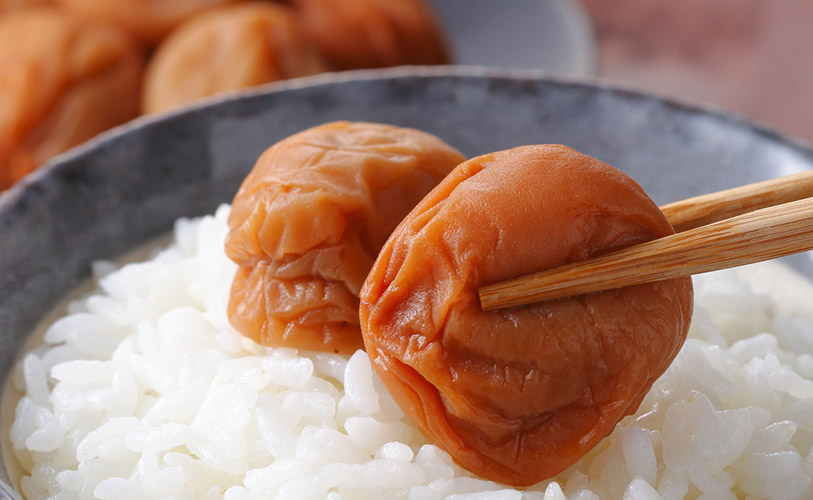
Ume was first introduced to Japan from China as a form of traditional medicine, called “Ubai” or dried, smoked, unripe Ume, around 700 A.D. in the Asuka Period.
Japanese people began making umeboshi during the Heian period (794-1185). Ume was popular as a foodstuff (umeboshi) and also for medical treatment. It was mentioned in Japan’s Oldest Medical Document and recorded in an encyclopedia published during the Edo period (1603 – 1868).
Umeboshi was Used Among Samurai in Muromachi Period
During the war in Muromachi Period (1336 – 1573), the samurai used to carry umeboshi with them because umeboshi is believed to increase one’s appetite, removes irritation, and good for healing wounds. Besides, Umeboshi is can be preserved for a long time and the abundant nutrients endures.
Therefore, the samurai consumed umeboshi to help them regain their strength and appetite on the battlefield. This also depicts the origin of how Ume trees became widespread across Japan. Umeboshi is gradually known not only as a foodstuff, but also for its medicinal effects.
Umeboshi as the Antidote for Cholera Epidemic in Meiji Period
Cholera marked the massive epidemic in 1875 (Meiji 8th years). During this period, umeboshi played an important role as an antidote for cholera. Due to the citric acid content in umeboshi having strong sterilizing effect, Umeboshi is used for treatment.
It is said that people with cholera got better after consuming umeboshi. Umeboshi helped to prevent and cures some health problems, as the next section underlines.
Health Benefits of Umeboshi
1. Fatigue Recovery, Increase Appetite
Plum contains Citric acid, which is a source to recover from fatigue and exhaustion. This acid is packed with antioxidants and helps to boost metabolism in the body. Consuming umeboshi protects your body from the winter cold and the fatigue caused by the summer heat. Saliva stimulation by citric acid also increases the appetite. As digestive enzymes increases, it aids digestion and food absorption.

2. Beauty Benefits and Balanced Lifestyle
Citric acid in plums contain an abundance of antioxidant ingredients such as ‘polyphenol’, ‘vitamin E’, and ‘plum lignan’ which soften and smooth the skin.
It also helps to contribute to a balance lifestyle. Eating umeboshi will neutralize toxic acids from high acid foods (such as sugar and processed foods) which usually causes health problems. The acidity of citric acid and the alkalinity of salt from umeboshi also helps your organs to detoxify efficiently. Let’s take care of our body from the inside out!

3. Prevent Food Poisoning and Relieves Hangover
The “bactericidal action” in citric acid is well known to ward off food poisoning. Placing Umeboshi in a lunch box (bento) also reduces oxidation.
Umeboshi replaces electrolytes like sodium and potassium you lose when drinking, which relieve hangover syndromes. It is recommended to take Umeboshi or Umeboshi extract before getting a drink to relieve hangover afterwards.

4. Improve Blood Circulation & Liver Function
“Pyruvic acid” contained in Umeboshi is said to improve liver function. The antioxidants may help lower inflammation, prevent blood clots, and improve blood circulation.
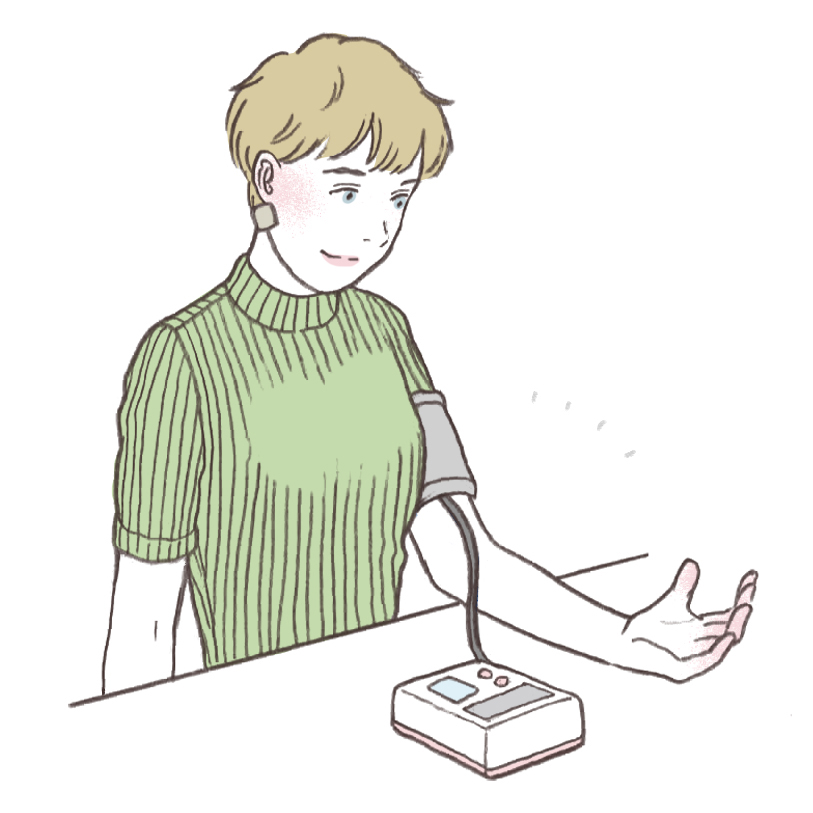
5. Prevent Stomach Cancer
Several lines of research show that the ingredients contained in citric acid can serve as glycolysis suppressor to inhibit growth of some tumor cells. Besides, they suppresses the growth of “Helicobacter pylori” which causes stomach cancer. By consuming Umeboshi in small portions consistently every day, it is believed to prevent cancer.

How to Choose Delicious Umeboshi

Umeboshi are traditional Japanese sour plums made through preservation. The traditional recipe requires little to no additive, with a salt content of over 20%. If the environment and climate are fitting, some preserved plums can be consumed over 100 years.
Lately, there has been many commercially produced Umeboshi sold in the market. Large amount of additives are added to dried and salted plums, such as chemical seasonings, sweeteners and acidulants. Although the salt content is significantly lesser, the authentic touch is lost because of chemical additives.
For the health-conscious crowd who wish to enjoy traditionally preserved umeboshi, we recommend getting your hands on pickled plums made without additives. This reflects the true devotion of manufacturers that went the extra mile to serve quality foods safe for all.
Wakayama Prefecture is Famous for its Umeboshi
From the highest mountain in Kishu of Wakayama Prefecture towards the vast open valley of Hidakawa river, resides the nature and history Japanese plums. Wakayama prefecture, located in Honshu (main island) is well-known for its large umeboshi harvest.
Wakayama Prefecture is home to the largest plum production in Japan. The town of Minabe, Wakayama, in particular, grows more ume and produces more umeboshi than any other town in Japan. Wakayama alone harvests 60% of the country’s plum yield. Our manufacturer, Ryujin Plum produces more than 50 tons of products every year without the use of pesticides or chemical fertilizers. Plums are cultivated the old-fashioned way by using natural composts such as tree bark.
Are dotted Umeboshi safe for consumption?
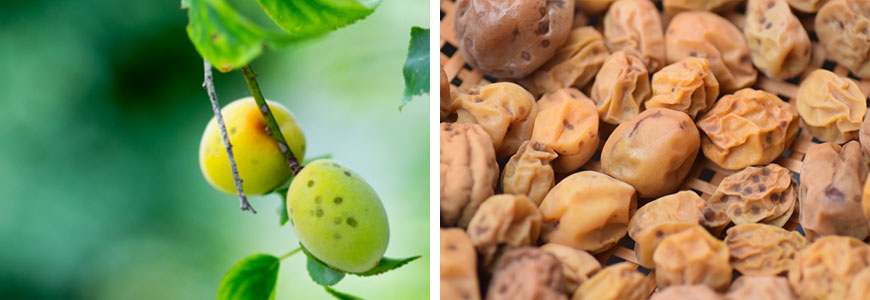
Some may be wondering, “Is it okay to consume umeboshi that has black dots?”
Absolutely! In fact, black dots are mold caused by fungus and does not affect the taste of plums. Due to pesticide-free cultivation, the possibility of bearing fruits with black dots are high. However, rest assured that the black dots are sterilized when the plums are salted and pickled.
For homemade umeboshi, you can simply peel off the black dots together with the ume’s stem before giving it a thorough wash. This way, you can enjoy umeboshi without black dots.
How to Eat Umeboshi Deliciously
The assertive mixture of salt and sour make Umeboshi an acquired taste. These salted Japanese plums may be intense on its own, which is why most Japanese people find it addictive and beloved for centuries.
“Umeboshi” is the Typical Ingredient for “Onigiri”
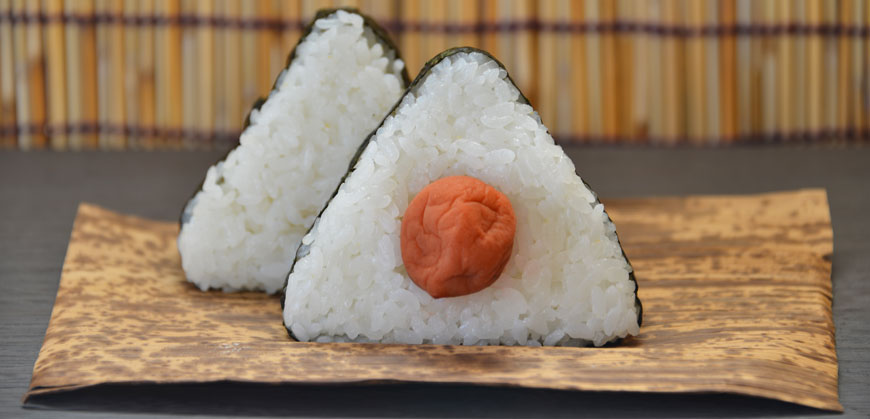
Onigiri or Japanese rice ball has always been one of the representatives of Japanese food. Before refrigerators exist, Japanese people came up with a method to keep rice fresh for longer by adding natural preservatives such as salty or sour ingredients. That is also why salt is rubbed onto the palm when making onigiri in order to keep it for much longer.
Traditionally, onigiri is filled with umeboshi, salted salmon, katsuobushi, or other salty or sour ingredients. Umeboshi helps to prevent the rice from turning bad because citric acid prevents the growth of microorganisms. Onigiri is great for picnics, potluck, or bento for school or at work.
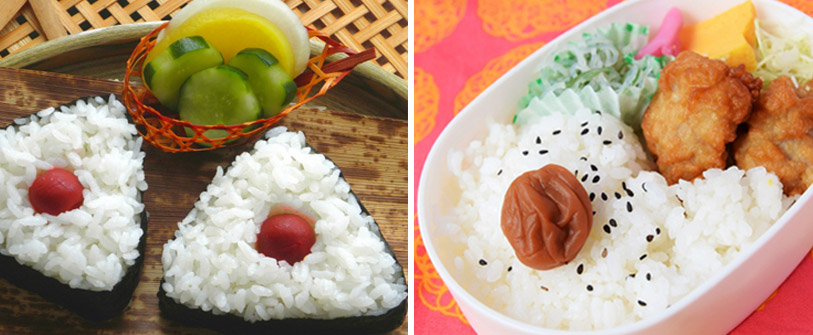
Learn how to make Umeboshi Onigiri here
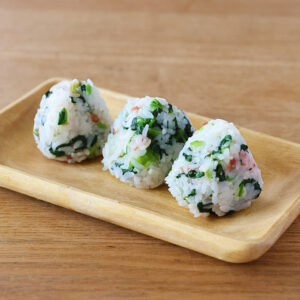
Other Ways
Japanese people usually eat umeboshi as a side dish with rice, or as a filling for rice balls (onigiri) mentioned above. Read on to discover more ways to enjoy umeboshi.
With sasami (chicken breast meat)
The combination of Umeboshi and chicken meat is simply delectable. The saltiness and sourness of Umeboshi becomes less penetrating, creating a mouthwatering dish.
To prepare, crush the Umeboshi until they become a paste. You can also add sake and mirin to the mix. Next, fill the chicken breast with the paste and then grill. Finally, wrap the chicken breast with perilla leaves and add Umeboshi paste on top as a finishing touch. The sasami-umeboshi roll is complete!
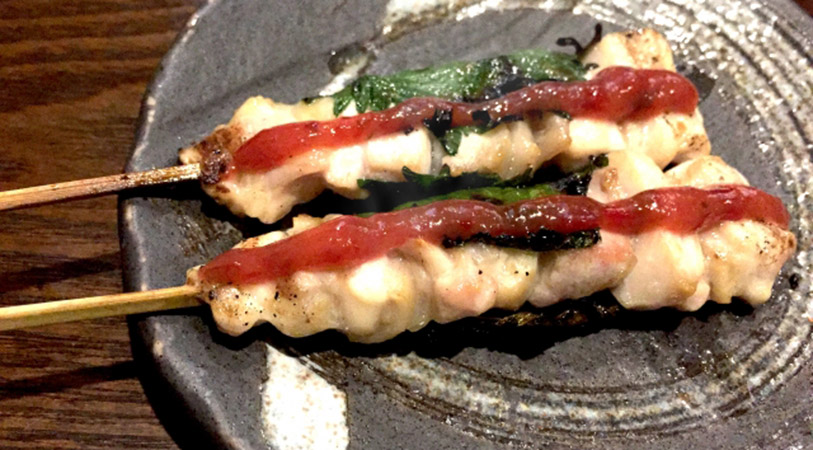
With cucumber
A refreshing and light side dish calls for cucumbers. To prepare, slice the cucumbers into small pieces. Next, sprinkle some salt and/or vinegar over it and finish off with some chopped umeboshi. Ginger is optional but it does make a difference!
Alternatively, the combination of cucumber and chopped Umeboshi will make an interesting addition to stir-fry dishes. Simply add chopped umeboshi and cucumber into the pan, and sauté along with meat and perilla leaves. Bon Appétit!
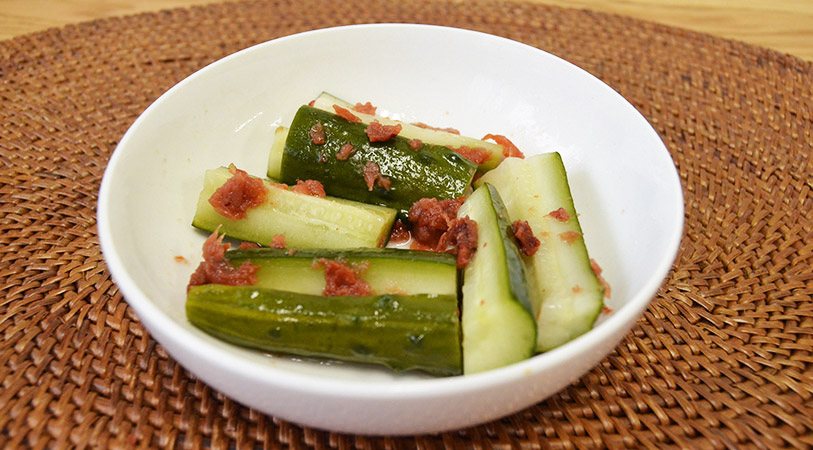
With cold tofu or spaghetti
Hiyayakko (冷奴) or cold tofu is an amazing accompaniment to umeboshi. To prepare, place umeboshi on top of cold tofu as a garnish and finish off with some katsuobushi (dried tuna/bonito).
Umeboshi is no stranger to fusion dishes. To prepare “Japanese style spaghetti” or wafuu spaghetti, first sauté some garlic, onion and mushrooms in a pan. Next, add chopped Umeboshi and cooked spaghetti, finally stir to combine. Itadakimasu!
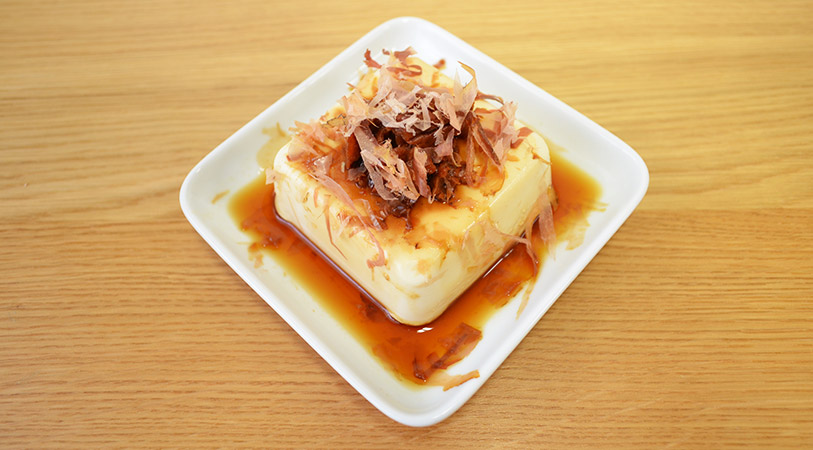
There are plenty of ways to consume umeboshi and savour its goodness! Connect with us if you’d like to share more ways to enjoy Umeboshi better.
Read also our recipe articles to Enjoy Umeboshi:
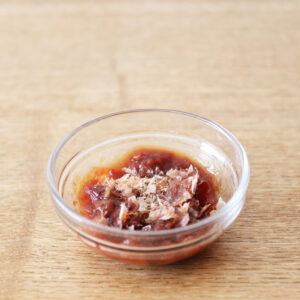
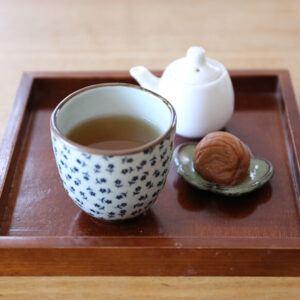
How to Remove Salt Content from Umeboshi?
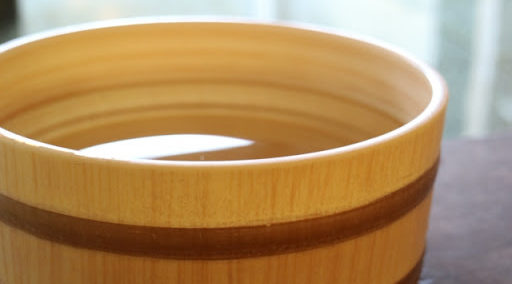
For those who are concern about the high salt content, fret not! To remove or de-salt the salt concentration, simply follow the guide below.
Note: The lower the salt content, the shorter the shelf life
Procedure for salt removal from plums
- 1. Prepare 1L of water for 200g (about 10 pieces) of dried plums.
- 2. Combine water, dried plums, and a pinch of salt into the container and stir well.
-
- Points:
- ● By adding salt, salt removal is easier due to osmotic pressure.
- ● Stir occasionally or else salt will settle on the plums.
- ● Warm-hot water will help to remove salt content more quickly.
- 3. Desalt for an hour or more depending on your preference.
- 4. After desalting, drain well with a colander and let dry for several hours.
- 5. Store in the refrigerator and consume as soon as possible.
Duration for salt removal (for umeboshi with 20% salt concentration)
- ・Pickled for 3 hours…Approximately 15%
- ・Pickled for half-day…Approximately 12%
- ・Pickled for half-day, water replaced once and then pickled for another half-day…Approximately 5-10%
Please note that weather, humidity and environment may affect the end-product.
How to Store Umeboshi?
Traditional umeboshi made without much additives are considered to be well-preserved food. The ideal way to store umeboshi is to store it in an earthenware pot (甕, or “Kame”) at room temperature. Earthenware pot or the ceramic pot is the most suitable as it maintains the quality of umeboshi for a long time. Umeboshi cultivated with traditional methods need not be refrigerated.
Important points:
● Avoid direct sunlight.
● Avoid metal and plastic storage containers as they may easily erode.
FAQ about Umeboshi
- What does umeboshi taste like?
- Umeboshi is a popular kind of tsukemono (pickles) in Japan. It has a lovely tartness and tanginess which often tastes sour and salty due to the citric content. When pickled with honey, a fruity flavour from the sweet-sour combination produces sweet Umeboshi.
- What is the history of umeboshi in Japan?
- Ume was first introduced to Japan from China as a form of traditional medicine, called “Ubai” around 700 A.D. in the Asuka Period. Japanese people began making umeboshi during the Heian period (794-1185). Umeboshi plays an important role as an antidote against cholera during the Cholera Epidemic in The Meiji Period. Besides, it was also used for medical treatment.
- How can I remove the salt content from Umeboshi?
- To reduce or remove the salt content, first prepare a bowl of water. Then soak the umeboshi in the water for about half a day. By estimation, the salt content will reduce from approximately 18% to 13% in half a day.
Please note that weather, humidity and environment may affect the end-product.
- What are some of the benefits to consuming Umeboshi?
- Umeboshi is rich in organic acids such as citric acid, malic acid, polyphenol and more. Due to its abundance of nutrients, umeboshi is known as a remedy for exhaustion, have strong bactericidal effect to ward off food poisoning, contributes to a balanced lifestyle, improve blood circulation and suppress the development of cancer.
- I bought umeboshi that has black dots in it. Is it edible?
- Yes, it is. Black dots are mold caused by fungus and does not affect the taste of plums. Due to pesticide-free cultivation, the possibility of bearing fruits with black dots are high. However, rest assured that the black dots are sterilised when the plums are salted and pickled.
- How long does umeboshi last?
- The shelf life of Umeboshi depends on the salt content. It will not turn bad even if it is stored for a long period of time. However, the color will gradually fade and the fruity flavor will become faint. When we store umeboshi for a long time, the plum vinegar dries out and the texture hardens. The flesh of aged Umeboshi becomes brittle and the taste turns mellow. Based on personal preferences, some may enjoy plums with hard texture, while others may prefer fresh and juicy umeboshi.
- What is the right way to store umeboshi?
- The ideal way to store umeboshi is to store it in an earthenware pot (甕, or “Kame”) at room temperature. Earthenware pot or the ceramic pot is the most suitable as it maintains the quality of umeboshi for a long time. Umeboshi cultivated with traditional methods need not be refrigerated.
- How do you eat umeboshi?
-
● Japanese people usually eat umeboshi as side dishes with rice, or as a filling for rice balls (onigiri).
● Minced or chopped Umeboshi is also a popular option to savour Umeboshi in small portions. They can be enjoyed with cucumber, cold tofu (Hiyayakko), or in Japanese-style umeboshi spaghetti.
● Alternatively, Umeboshi can be turned into a paste to compliment meat dishes such as fried or grilled chicken breast meat.
- What is umeboshi paste? I heard it is used to substitute salt or vinegar.
- Umeboshi paste is a puree derived from ume, made by smashing umeboshi into a pulpy liquid. The paste is sour and salty, similar to that of umeboshi but in a different form. You can use it to substitute salt or vinegar. Simply add this ‘puree’ to your salads, soups or as condiments to savoury dishes.
- Where can I buy Umeboshi and Umeboshi Paste?
-
In Japan, you can buy Umeboshi products from regular supermarkets or department stores. For those residing outside Japan, you can buy Umeboshi products at artisan Umeboshi shops, Asian markets that carry Japanese foodstuffs or resort to online platforms that sell a great variety of Umeboshi products.
We also recommend trying out pesticide-free and non-additives umeboshi products from our curated list here. Keen to make your own homemade umeboshi? Read more in our article: “How To Make Umeboshi”.
Recommended Products
Recommended Umeboshi
Recommended Umeboshi Paste
Recommended Crushed Umeboshi
Recommended Umeboshi Vinegar

